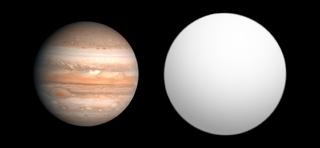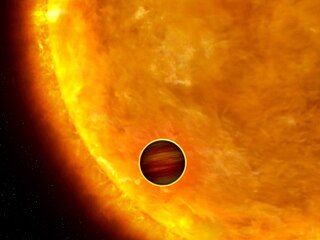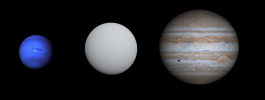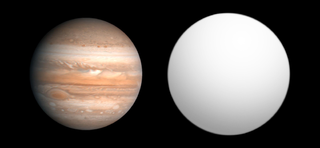Related Research Articles

CoRoT was a space telescope mission which operated from 2006 to 2013. The mission's two objectives were to search for extrasolar planets with short orbital periods, particularly those of large terrestrial size, and to perform asteroseismology by measuring solar-like oscillations in stars. The mission was led by the French Space Agency (CNES) in conjunction with the European Space Agency (ESA) and other international partners.

CoRoT-2b is the second extrasolar planet to be detected by the French-led CoRoT mission, and orbits the star CoRoT-2 at a distance of 700 light years from Earth towards the constellation Aquila. Its discovery was announced on 20 December 2007. After its discovery via the transit method, its mass was confirmed via the radial velocity method.

CoRoT-3b is a brown dwarf or massive extrasolar planet with a mass 21.66 times that of Jupiter. The object orbits an F-type star in the constellation of Aquila. The orbit is circular and takes 4.2568 days to complete. It was discovered by the French-led CoRoT mission which detected the dimming of the parent star's light as CoRoT-3b passes in front of it.

CoRoT-6b is an exoplanet that was discovered by the CoRoT mission team on February 2, 2009, orbiting the F type star CoRoT-6. It is located in the Ophiuchus constellation.

CoRoT-1 is a yellow dwarf main sequence star similar to the Sun. The star is located approximately 2,510 light-years away in the constellation of Monoceros. The apparent magnitude of this star is 13.6, which means it is not visible to the naked eye; however, it can be seen through a medium-sized amateur telescope on a clear, dark night. The first exoplanet discovered in the course of the CoRoT mission orbits this star; it is considered to be a "hot Jupiter", and is approximately as massive as the planet Jupiter itself.
CoRoT-2 is a yellow dwarf main sequence star a little cooler than the Sun. This star is located approximately 700 light-years away in the constellation of Aquila. The apparent magnitude of this star is 12, which means it is not visible to the naked eye but can be seen with a medium-sized amateur telescope on a clear dark night.
CoRoT-13b is a transiting exoplanet found by the CoRoT space telescope on 12 July 2010.
CoRoT-21b is a transiting exoplanet reportedly found by the CoRoT space telescope in 2011. Planetary parameters were published in 2012.

CoRoT-8b is a transiting exoplanet orbiting the K-type main sequence star CoRoT-8 1,050 light years away in the equatorial constellation Aquila. The planet was discovered in April 2010 by the CoRoT telescope.
CoRoT-10b is a transiting Hot Jupiter exoplanet found by the CoRoT space telescope in 2010.

CoRoT-11b is a transiting Hot Jupiter-sized exoplanet found by the CoRoT space telescope in 2010.

CoRoT-12b is a transiting Hot Jupiter-sized exoplanet found by the CoRoT space telescope in 2010.

CoRoT-14b is a transiting Hot Jupiter exoplanet found by the CoRoT space telescope in 2010.
CoRoT-17b is a transiting Hot Jupiter exoplanet found by the CoRoT space telescope in 2011.
CoRoT-18b is a transiting hot Jupiter exoplanet found by the CoRoT space telescope in 2011.
CoRoT-19b is a transiting exoplanet found by the CoRoT space telescope in 2011.
CoRoT-20b is a transiting exoplanet found by the CoRoT space telescope in 2011.
CoRoT-22b is a transiting exoplanet smaller than Uranus found by the CoRoT space telescope in 2011 and confirmed in 2014.
Kepler-1704b is a super-Jupiter on a highly eccentric orbit around the star Kepler-1704. It has a mass of 4.51 MJ. The planet's distance from its star varies from 0.16 to 3.9 AU. It is a failed hot Jupiter, having been scattered from its birth orbit to orbit with a periastron just above the tidal circularization distance.
CoRoT-23 is a star located in the constellation Serpens at a distance of about 1956 light-years from us. At least one planet revolves around the star.
References
- ↑ "Notes on CoRoT-23 b". Extrasolar Planets Encyclopaedia . Retrieved February 25, 2019.
- ↑ "CoRoT-23 Planets in the system" . Retrieved February 25, 2019.
- 1 2 Rouan, D.; et al. (2012). "Transiting exoplanets from the CoRoT space mission . XIX. CoRoT-23b: A dense hot Jupiter on an eccentric orbit". Astronomy and Astrophysics. 537: A54. arXiv: 1112.0584 . Bibcode:2012A&A...537A..54R. doi:10.1051/0004-6361/201117916. S2CID 55219945.